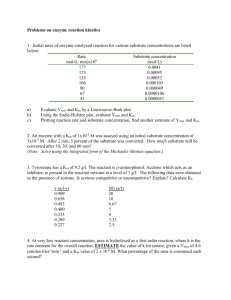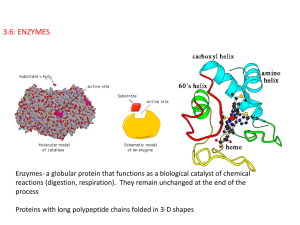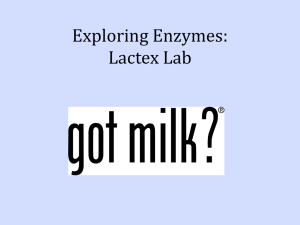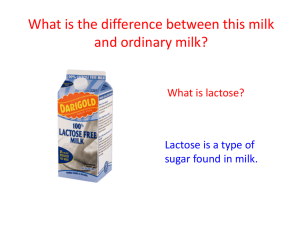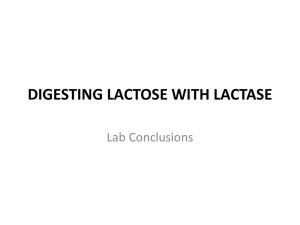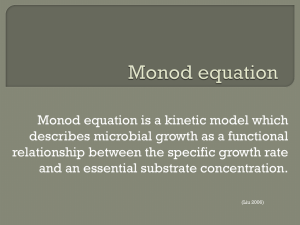3.6: ENZYMES - HS Biology IB
advertisement
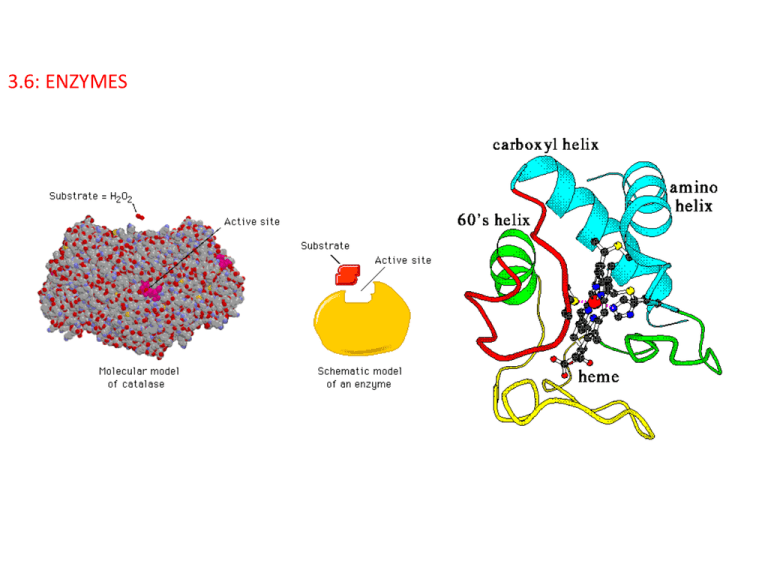
3.6: ENZYMES 3.6.1: Define enzyme and active site. 3.6.2: Explain enzyme–substrate specificity. • Lock and key model IB Question: (a) Define active site. (b) Explain enzyme-substrate specificity. (a)Define active site. site on surface/portion of the enzyme/protein to which the substrate binds (b) Explain enzyme-substrate specificity. enzymes fit together with substrates similar to a lock and key; active site has shape that gives specificity; enzymes catalyze a reaction with a specific substrate; example of named enzyme and its substrate; substrate held precisely in (optimum) position to make/break bonds/carry out reaction / chemical interaction occurs between enzyme and substrate; [3 max] Accept these points shown in an annotated drawing. 3.6.3: Explain the effects of temperature, pH and substrate concentration on enzyme activity. 3.6.3:Effect of pH IB QUESTION: Explain the effects of pH on enzyme catalysed reactions. [3] enzymes have a pH optimum; active site works best at this pH; activity decreases above and below the optimum; by interfering with H-bonding/active site structure; denaturing by extremes of pH so enzyme activity/reaction stops; [3 max] IB Question: The enzyme pepsin, involved in protein digestion in the stomach, requires an acid pH to work properly. Explain the effect of pH on enzyme activity. [2] IB Question: The enzyme pepsin, involved in protein digestion in the stomach, requires an acid pH to work properly. Explain the effect of pH on enzyme activity. [2] each enzyme has an optimum pH where enzyme functions best / drawing of bell curve with optimal pH labelled; changes in pH (from optimum pH) decrease activity/effectiveness; pH slightly changes the shape of the active site / tertiary structure of protein changed / enzyme denatured; more difficult to form enzyme-substrate complex; [2 max] N.B. Accept above marking points if given through a specific example such as pepsinogen conversion to pepsin when pH is lowered. 3.6.3: Effect of substrate concentration IB Question: Explain why enzymes are substrate specific and why their activity is affected by substrate concentration. [8] IB Question: Explain why enzymes are substrate specific and why their activity is affected by substrate concentration. [8] specificity: (active site works as a) lock and (substrate as a) key; (enzyme has) a specific shape; active site; (substrate has) a specific/complementary shape; (active site) fits substrate molecule/part of molecule / enzyme-substrate complex formed; activation energy lowered; substrate concentration: lower/medium concentration activity increases; directly proportional to concentration of substrate; random collisions more frequent; activity levels off / plateau; high concentration no change in activity; as all active sites fully utilised; [8 max] Award [6 max] if only specificity or substrate concentration aspects addressed. 3.6.4: Define denaturation. Denaturation is a structural change in a protein that results in the loss (usually permanent) of its biological properties. Refer only to heat and pH as agents. 3.6.5 Explain the use of lactase in the production of lactose-free milk. Milk naturally contains a disaccharide sugar called lactose. During the normal digestion of milk, the enzyme lactase (made by yeast cells found in milk) breaks lactose into its two monomers: glucose and galactose. Both monomers are small enough to pass through the lining of the small intestine to be absorbed by the bloodstream. Lactose, however, is too large to pass through the intestinal lining. Some individuals are lactose-intolerant; as lactose passes through their digestive tracts it can cause irritation and diarrhea. Lactose intolerance is common in Southeast Asia where people evolved without milk in their diets. In Europe and the Middle East, by contrast, human populations have consumed milk for millennia and have therefore evolved the ability to tolerate lactose. Lactose-intolerant people can drink milk that has had lactase added to remove the lactose. The lactase added to “lactose-free” milk is obtained from a type of yeast called Kluveromyces lactis. Kluveromyces lactis is cultured by biotechnology companies that extract and purify the lactase. The purified lactase has the following applications in the dairy food industry: IB Question: Describe the use of biotechnology in the production of lactose-free milk. [6] IB Question: Describe the use of biotechnology in the production of lactose-free milk. [6] it allows people who are lactose intolerant/have difficulty digesting lactose to consume milk (products); galactose and glucose taste sweeter than lactose reducing need for additional sweetener (in flavoured milk products); galactose and glucose are more soluble than lactose / gives smoother texture / reduces crystalization in ice cream; (bacteria) ferment glucose and galactose more rapidly (than lactose) shortening production time (of yogurt/cottage cheese); IB Question: Lactase is widely used in food processing. Explain three reasons for converting lactose to glucose and galactose during food processing. [3] IB Question: Lactase is widely used in food processing. Explain three reasons for converting lactose to glucose and galactose during food processing. [3] it allows people who are lactose intolerant/have difficulty digesting lactose to consume milk (products); galactose and glucose taste sweeter than lactose reducing need for additional sweetener (in flavoured milk products); galactose and glucose are more soluble than lactose / gives smoother texture / reduces crystalization in ice cream; (bacteria) ferment glucose and galactose more rapidly (than lactose) shortening production time (of yogurt/cottage cheese);
